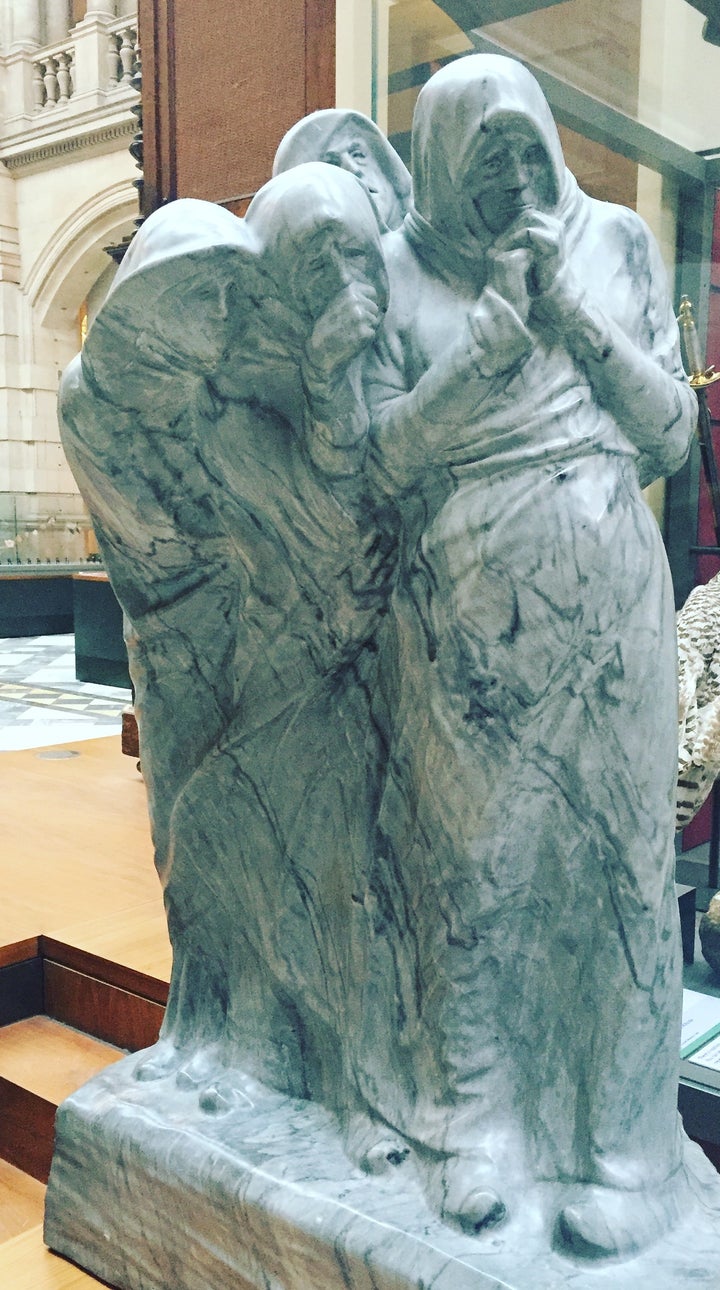
“Wives of Fishermen,” Pieter Braecke. Kelvingrove Art Gallery and Museum, Glasgow, Scotland.
Like many other liberal-minded, white, progressive people in this country, I have spent the past week processing the results of not only a Trump presidency, but also a Republican controlled house and senate. Although it seemed like the last thing I wanted to do at the time, I was lucky enough to spend the immediate days following the election at an academic conference with fellow academics who were thoughtfully engaged in the work of processing. We shared strategies for action, discussed “getting to work” organizing, and expressed disbelief at the outcome of the election. “How could this happen?” we asked ourselves, shaking our heads.
However, a lot of people at this conference expressed disappointment but not disbelief. Unsurprisingly, most of these people are members of the very demographics that Trump has targeted throughout his candidacy. Much has been written on the “disbelief gap” that exists within the “progressive group” who thought they were on the same side working for the same goals. This should not be a big shock. Post-election, Dave Chappell and Chris Rock hilariously mocked white disbelief on Saturday Night Live, film-maker and liberal activist, Michael Moore, who insisted months ago that Trump would win, has been all over news channels and social media talking about his predictions in relation to liberal disbelief. And there have been countless other writers on this very issue.
And, yet, there is still a sense of shock. White people, we have to admit and own this: our disbelief is a part of our privilege. And it needs to be unpacked. Yes, the polls suggested Hillary would win. Yes, we were all misled by a media that thought it could stream all of Trump’s hateful rhetoric and actions while still assuring us he would never really get elected. And, yes, many of us (I include myself here) placated ourselves with clips of John Oliver, Trevor Noah, and Samanta Bee to further insulate us from the possibilities of reality. “John Oliver is so funny! Surely everyone thinks so!” But here’s the thing: disbelief – the type many of us are experiencing as blunt-force shock in the face of the impossible – is a type of trauma that relies upon a particular belief in presumed stability. This is the very definition of “shock.” Ruptures occur and manifest as shock because they disrupt stability.
Let me explain. Cultural scholar and critic Dr. Jenny Edkins theorizes trauma as a “breach” in the presumed safety of a community or an institutional power. As Edkins and other scholars have noted, physical trauma is different from mental and emotional trauma. But various types of trauma overlap in intersecting ways as reproduced through stress responses. There are people who have experienced violent, shocking trauma that is qualitatively different from how I am using the term “trauma” here. I want to use her definition of trauma as a “breach” in the security or stability of whatever you found to be stable in your life. This concept of trauma is related to what scholars have written about as “white fragility.”
In her piece, White Fragility, cultural theorist and scholar, Dr. Robin Diangelo writes:
White people in North America live in a social environment that protects and insulates them from race-based stress. This insulated environment of racial protection builds white expectations for racial comfort while at the same time lowering the ability to tolerate racial stress, leading to what I refer to as White Fragility. White Fragility is a state in which even a minimum amount of racial stress becomes intolerable, triggering a range of defensive moves.
DiAngelo’s term, white fragility, relates to this concept of traumatic breach along racial lines. This is not to discount the very real trauma many women who have been sexually assaulted feel at the reality of Trump’s election, and it would be unproductive to engage in a type of trauma Olympics, wherein we fight over who should be more traumatized by a Trump presidency.
Rather, the point I am making, is that the concept of traumatic breach might be a useful way for white liberals to unpack their disbelief in this election’s outcome.
I have written about “traumatic breach” elsewhere in my scholarly work, and I think it could apply here also. We experience types of trauma when we experience a breach in a presumed belief of security. If trauma manifests itself as a function of that breach, then we have to acknowledge that “breaches” occur in relation to institutions that we believe(d) to be stable. In other words, for ruptures to occur – physically, emotionally, or otherwise – you also have to believe in stable pieces before and after it. Edkins suggests that the stable pieces can be wherever someone finds their security in an institution – if child abuse is your trauma, then your stability was (in part) the belief in a family institution that was safe and protective. If war is your trauma, then your security was the nationstate you found stability and comfort in. See, that’s how traumatic breaches occur – they rupture the places we wanted to believe were stable. As with all theories, there is more complexity here than I have time to discuss. But this is what can be unpacked, what can reveal other social blind spots and pieces of privilege we forgot to check.
So, ask yourself this question to self-reflexively unpack your disbelief: what are the stable pieces that exist around my “traumatic breach” from this election? What did you believe to be so stable in your life that this breach has ruptured? This will be different for different groups of people and will depend upon lived experiences. The people of color I have talked with do not express the same stabilities I previously believed in. Many have never felt safe. The nationstate and the security of their place in it has never been a source of believable safety, stability, and progress.
Unpack your places of presumed stability. That’s where there’s work for white people to do. That’s where I’m working going forward – within the spaces that encouraged me to feel safe enough to now be shocked.
